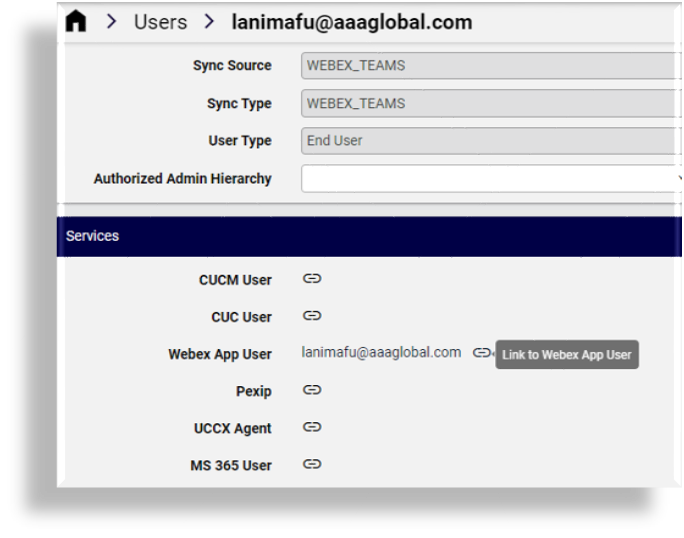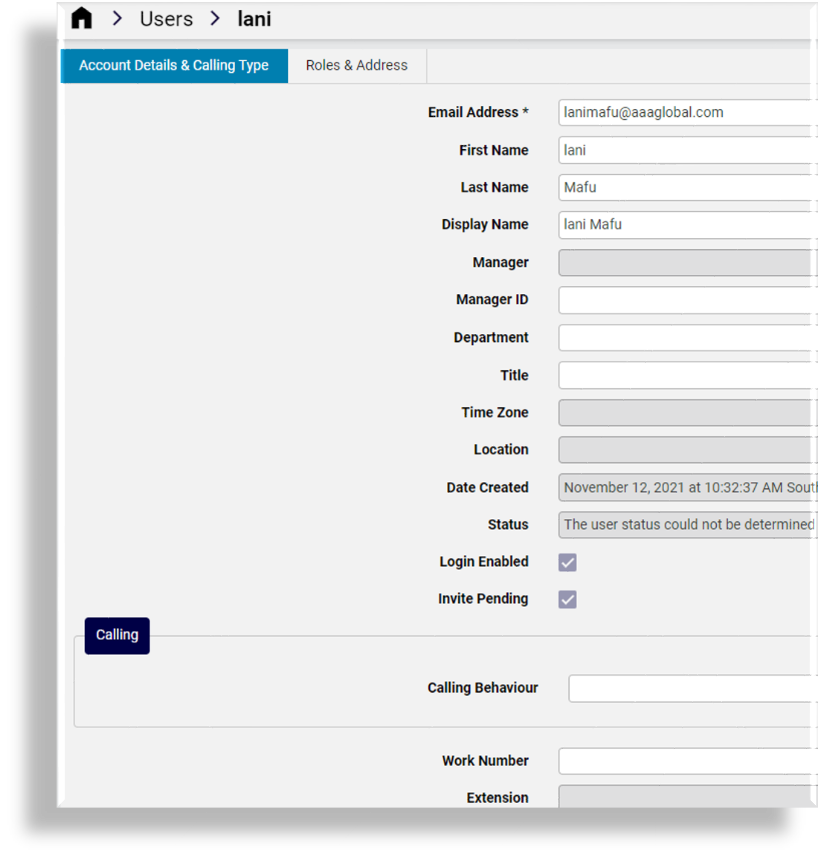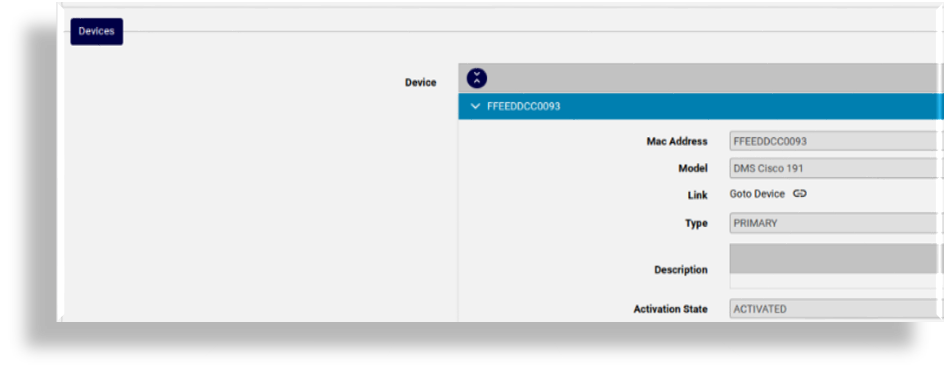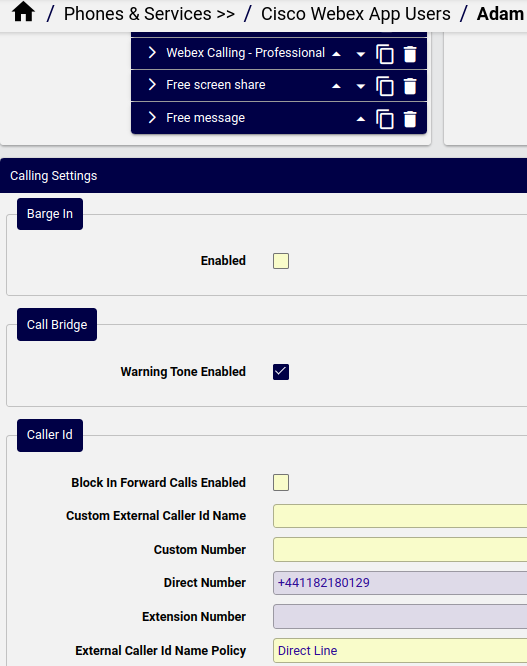Users (Webex App)#
Overview#
You can add Webex App users into Automate in various ways:
Add Webex App user via (default menus) Cisco Webex App > Users. See Add Cisco Webex App User via Cisco Webex App Menu
Add Webex App user via Webex Teams Quick Subscriber. See Quick Subscriber (Webex App)
Add Webex App user via (default menus) Subscriber Management > Subscribers. See Add a Subscriber
Add Webex App user via flow through provisioning. See Sync Webex App Users with Flow-through Provisioning
Add Webex App user via (default menus) Subscriber Management > Quick Add Subscriber (QAS)
Note
In this case, choose a Webex Teams User Template from the drop-down, or use the default user template (which is referenced in the Quick Add Subscriber Groups* associated with the user).
If you want customized values, clone the Webex Teams User Template (via Customizations > Configuration Templates), and edit as required.
Related Topics
Provision Cisco Webex for an existing user (see Provisioning Subscribers with Cisco Webex)
View Cisco Webex App User#
To view a Cisco Webex App user:
Open the Webex App user’s settings. Two options:
View the list of users on the Users page (
relation/User). Select the relevant Webex Teams user to open their user management page. Here you can click the link (in the Services fieldset) to go to their Webex App user settings (relation/SparkUser).
View the list of Webex App users on the Cisco Webex App Users page (
relation/SparkUser), then click on the relevant user to view their Webex App user settings.
On the Webex App user’s detail page, view their account details and calling type, and their roles and addresses.
If the user is associated with a phone (device) you can click the link adjacent to the device to go to
relation/WebexDeviceto view and manage the device settings.
Delete a Cisco Webex App User#
This procedure deletes an existing Cisco Webex App user (synced, or added via VOSS Automate).
Log in to the Admin Portal as a Provider, Reseller, Customer, or Site administrator.
Set the hierarchy to the Customer or Site level.
Go to (default menus) Cisco Webex App > Users.
Choose the Webex users you wish to delete (one or more).
Click Delete.
Click Yes to confirm.
Note
When deleting a subscriber with Cisco Webex App, the internal number inventory (INI) is updated as the number status is changed to Available, and the description, if any, is removed.
Provisioning Subscribers with Cisco Webex#
This section describes how to provision Cisco Webex for a subscriber, either via the Subscriber list view, or via Quick Add Subscriber (QAS).
Related Topics
Provision Cisco Webex via Subscriber list view#
This procedure provisions a subscriber with Cisco Webex, via the Subscriber list view.
Prerequisite:
The users entitlement profile must have Cisco Webex enabled (Webex App checkbox must be selected).
Unless Cisco Webex service assigned is Message only, new users must have an input line specified, and existing users must have either a primary extension, or an input line must be specified.
To provision a subscriber with Webex:
In the Admin Portal, go to (default menus) Subscriber Management > Subscribers.
From the Subscribers list, click on a subscriber you wish to provision with Cisco Webex.
On the subscriber configuration screen, select the Webex App panel (or if selected as display option, the tab).
In the Webex App User field, expand the Webex App User configuration fields.
Note
The following Invite Pending checkbox is read-only, indicating the user’s status (whether their Webex account is active).
Options in the Manager ID and Location fields depend on the Cisco Webex Server to which the Cisco Webex Service is synced.
The Calling Behaviour field can be “Calling in Webex App”, “Calling in Webex App (Unified CM)”, “Cisco Jabber app” or “Third-Party app”.
In the Assigned License section, the available licenses depend on the Cisco Webex Server to which the Cisco Webex Service is synced.
In the Roles section, select the relevant check boxes to configure the required roles:
No administrator privileges
.
Full administrator privileges
Access to all of Portal features, including:
Assign roles
Company policy and templates
Device management licenses and upgrades
Read-only administrator privileges
View only access to privileges available to a full administrator.
Support Administrator
Access to user information and support logs.
User and Device Administrator
.
Device Administrator
.
Click OK. Cisco Webex is provisioned for the subscriber.
To verify, ensure the Webex App column in the Subscribers list view displays the text, Enabled.
Provision Cisco Webex via Quick Add Subscriber#
This procedure enables Cisco Webex for a subscriber via Quick Add Subscriber (QAS).
Prerequisite:
The user’s entitlement profile must have Cisco Webex enabled (Webex App checkbox must be selected).
Unless Cisco Webex service assigned is Message only, new users must have an input line specified, and existing users must have either a primary extension, or an input line must be specified.
See Add Cisco Webex App User via Cisco Webex App Menu and Add Webex App Service using Quick Add Subscriber
Go to (default menus) Subscriber Management > Quick Add Subscriber.
From the Username drop-down list, choose the name of the subscriber to be provisioned with Cisco Webex.
Select the Webex App checkbox to enable Cisco Webex for the subscriber.
From the Webex Teams User Template drop-down list, choose the template you want to assign to the user.
Click Save. Cisco Webex is provisioned for the subscriber.
To verify that Cisco Webex is enabled for the subscriber, ensure the Webex App column in the Subscribers list view displays the text, Enabled.
Note
When Cisco Webex Calling (with CUCM) is removed from a Webex User, the ‘On-Prem UCM Calling’ license is removed from the Webex User.
Sync Webex App Users with Flow-through Provisioning#
When using sync with flow through provisioning for Cisco Webex users, you need to configure several settings in VOSS Automate (including flow through provisioning criteria) before the initial sync from the Webex Control Hub. See: Setting up Flow Through Provisioning.
Flow Through Provisioning has been enabled in the Global Settings for a hierarchy (see: Global Settings)
The Webex settings on the Site Defaults (see: Site Defaults) matching the user’s location have been configured so that Move Filter Criteria are
webexUserModelFilterCriteria.These criteria are used as a part of a subscriber profile.
The workflow AddSubscriberFromProfile at site uses CFT:
Webex_FlowThroughProvisioning_SubscriberFromProfile
This allows VOSS Automate to apply the correct configuration, licenses and services to imported users; and to move users to sites.
Once you run the sync, users are imported, provisioned, licensed, and moved to the correct synced in sites, as subscribers - in accordance with configured Webex User Model Filter Criteria and Subscriber Profile.
Important
Webex Control Hub users who have been assigned Webex Calling Professional licenses and have a Location assigned, this location will not be overwritten by any site setting configured in the VOSS Automate user move component (Model Filter Criteria) of Flow Through Provisioning.
The flowchart sets out the sync with flow through of Cisco Webex users and services.
Related Topics

